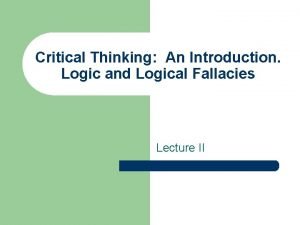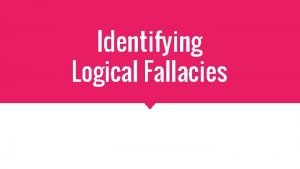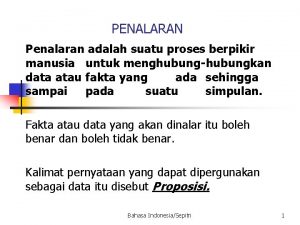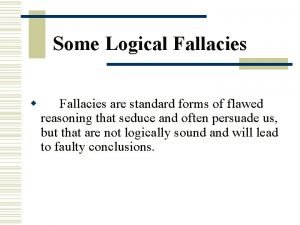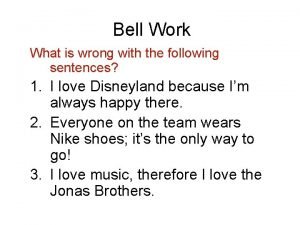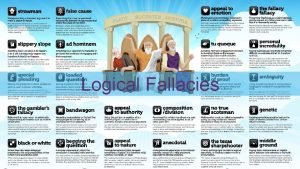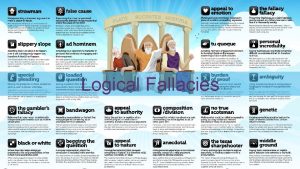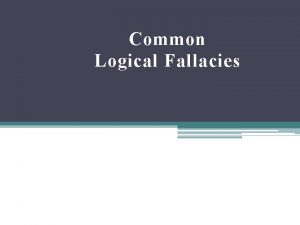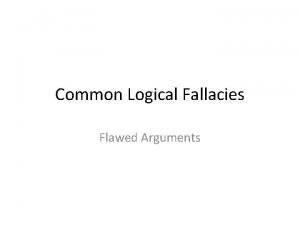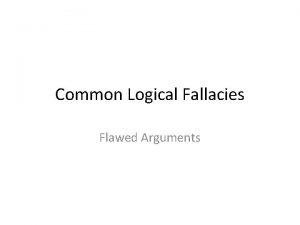FALLACIES OF ARGUMENT Logical Fallacies Ad hominem Translated















- Slides: 15

FALLACIES OF ARGUMENT Logical Fallacies

Ad hominem � Translated from Latin to English, "Ad Hominem" means "against the man" or "against the person. " � An Ad Hominem is a general category of fallacies in which a claim or argument is rejected on the basis of some irrelevant fact about the author of or the person presenting the claim or argument. This type of "argument" has the following form: � Person A makes claim X. Person B makes an attack on person A. Therefore A's claim is false. � � � The reason why an Ad Hominem (of any kind) is a fallacy is that the character, circumstances, or actions of a person do not (in most cases) have a bearing on the truth or falsity of the claim being made (or the quality of the argument being made).

Ad hominem � What are examples of ad hominem that you have witnessed lately?

Scare Tactics � � � Description of Appeal to Fear The Appeal to Fear is a fallacy with the following pattern: Y is presented (a claim that is intended to produce fear). Therefore claim X is true (a claim that is generally, but need not be, related to Y in some manner). This line of "reasoning" is fallacious because creating fear in people does not constitute evidence for a claim. � "You know, Professor Smith, I really need to get an A in this class. I'd like to stop by during your office hours later to discuss my grade. I'll be in your building anyways, visiting my father. He's your dean, by the way. I'll see you later. " � "I don't think a Red Ryder BB rifle would make a good present for you. They are very dangerous and you'll put your eye out. Now, don't you agree that you should think of another gift idea? " � You must believe that God exists. After all, if you do not accept the existence of God, then you will face the horrors of hell. " � "You shouldn't say such things against multiculturalism! If the chair heard what you were saying, you would never receive tenure. So, you had just better learn to accept that it is simply wrong to speak out against it. "

Scare Tactics � � Discuss with a partner some examples of advertisements or public messages that use Scare Tactics. Be prepared to share your ideas with the class.

Scare Tactics � � Scare Tactics reduce complicated issues to threats or exaggerate a possible danger well beyond its statistical likelihood. Some common examples of Scare Tactics : Either – Or Choices Slippery-Slope

Either-Or Choice (False Dilemma) � � � � Either claim X is true or claim Y is true (when X and Y could both be false). Claim Y is false. Therefore claim X is true. This line of "reasoning" is fallacious because if both claims could be false, then it cannot be inferred that one is true because the other is false. That this is the case is made clear by the following example: Either 1+1=4 or 1+1=12. It is not the case that 1+1=4. Therefore 1+1=12. In cases in which the two options are, in fact, the only two options, this line of reasoning is not fallacious. For example: Senator Jill: "We'll have to cut education funding this year. " Senator Bill: "Why? " Senator Jill: "Well, either we cut the social programs or we live with a huge deficit and we can't live with the deficit. " Bill: "Jill and I both support having prayer in public schools. " Jill: "Hey, I never said that!" Bill: "You're not an atheist are you Jill? " "Look, you are going to have to make up your mind. Either you decide that you can afford this stereo, or you decide you are going to do without music for a while. "

Either Or � What are some ways that people use “either or” arguments to persuade others?

Slippery Slope � The Slippery Slope is a fallacy in which a person asserts that some event must inevitably follow from another without any argument for the inevitability of the event in question. In most cases, there a series of steps or gradations between one event and the one in question and no reason is given as to why the intervening steps or gradations will simply be bypassed. This "argument" has the following form: � � Event X has occurred (or will or might occur). Therefore event Y will inevitably happen. This sort of "reasoning" is fallacious because there is no reason to believe that one event must inevitably follow from another without an argument for such a claim. This is especially clear in cases in which there is a significant number of steps or gradations between one event and another. � "We have to stop the tuition increase! The next thing you know, they'll be charging $40, 000 a semester!" � "The US shouldn't get involved militarily in other countries. Once the government sends in a few troops, it will then send in thousands to die. " � "You can never give anyone a break. If you do, they'll walk all over you. " � "We've got to stop them from banning books. Once they start banning one form of literature, they will never stop. Next thing you know, they will be burning all the books!" �

Sentimental Appeals � An Appeal to Pity is a fallacy in which a person substitutes a claim intended to create pity for evidence in an argument. The form of the "argument" is as follows: � P is presented, with the intent to create pity. Therefore claim C is true. This line of "reasoning" is fallacious because pity does not serve as evidence for a claim. This is extremely clear in the following case: "You must accept that 1+1=46, after all I'm dying. . . " While you may pity me because I am dying, it would hardly make my claim true. � � � It must be noted that there are cases in which claims that actually serve as evidence also evoke a feeling of pity. In such cases, the feeling of pity is still not evidence. The following is an example of a case in which a claim evokes pity and also serves as legitimate evidence: � Jill: "He'd be a terrible coach for the team. " Bill: "He had his heart set on the job, and it would break if he didn't get it. " Jill: "I guess he'll do an adequate job. " � � � "I'm positive that my work will meet your requirements. I really need the job since my grandmother is sick" � "I should receive an 'A' in this class. After all, if I don't get an 'A' I won't get the fellowship that I want. "

Bandwagon � The Bandwagon is a fallacy in which a threat of rejection by one's peers (or peer pressure) is substituted for evidence in an "argument. " This line of "reasoning" has the following form: � Person P is pressured by his/her peers or threatened with rejection. Therefore person P's claim X is false. This line of "reasoning" is fallacious because peer pressure and threat of rejection do not constitute evidence for rejecting a claim. This is expecially clear in the following example: � � � Joe: "Bill, I know you think that 1+1=2. But we don't accept that sort of thing in our group. " Bill: "I was just joking. Of course I don't believe that. " � It is clear that the pressure from Bill's group has no bearing on the truth of the claim that 1+1=2. � It should be noted that loyalty to a group and the need to belong can give people very strong reasons to conform to the views and positions of those groups. Further, from a practical standpoint we must often compromise our beliefs in order to belong to groups. However, this feeling of loyalty or the need to belong simply do not constitute evidence for a claim. � Bill says that he likes the idea that people should work for their welfare when they can. His friends laugh at him, accuse him of fascist leanings, and threaten to ostracize him from their group. He decides to recant and abandon his position to avoid rejection. � Bill thinks that welfare is needed in some cases. His friends in the Young Republicans taunt him every time he makes his views known. He accepts their views in order to avoid rejection. �

Bandwagon � What examples of bandwagon can you think of? � “In a democratic society, the bandwagon appeal is among the most potentially serious and permanently damaging fallacies of argument. ” � Turn to a partner and discuss what this means and why it is true. � Be ready to share your ideas with the class.

False Authority � An Appeal to Authority is a fallacy with the following form: � Person A is (claimed to be) an authority on subject S. Person A makes claim C about subject S. Therefore, C is true. This fallacy is committed when the person in question is not a legitimate authority on the subject. More formally, if person A is not qualified to make reliable claims in subject S, then the argument will be fallacious. � � This sort of reasoning is fallacious when the person in question is not an expert. � When a person falls prey to this fallacy, they are accepting a claim as true without there being adequate evidence to do so. The person is accepting the claim because they erroneously believe that the person making the claim is a legitimate expert and hence that the claim is reasonable to accept.

acceptable standards of assessment � � � The person has sufficient expertise in the subject matter in question. The claim being made by the person is within her area(s) of expertise. There is an adequate degree of agreement among the other experts in the subject in question. The person in question is not significantly biased. The area of expertise is a legitimate area or discipline. The authority in question must be identified.

FALLACIES Look for them, be aware of them, and question them. “Trust, but verify. ”
 Hominem uti hominem educare oportet
Hominem uti hominem educare oportet Logical fallacies propaganda
Logical fallacies propaganda Logical fallacies
Logical fallacies Logical fallacy referee
Logical fallacy referee Logical fallacies
Logical fallacies Logical fallacies detector
Logical fallacies detector Thou shalt not commit logical fallacies image
Thou shalt not commit logical fallacies image Hasty conclusion
Hasty conclusion Silogisme
Silogisme Appeal to vanity fallacy
Appeal to vanity fallacy Appeal to vanity fallacy
Appeal to vanity fallacy Fallacy examples
Fallacy examples Logical fallacies bell ringer journal
Logical fallacies bell ringer journal Examples of dogmatism fallacy
Examples of dogmatism fallacy Rhetorical devices vs logical fallacies
Rhetorical devices vs logical fallacies Hasty generalization
Hasty generalization


